Reviews

November 7, 2024
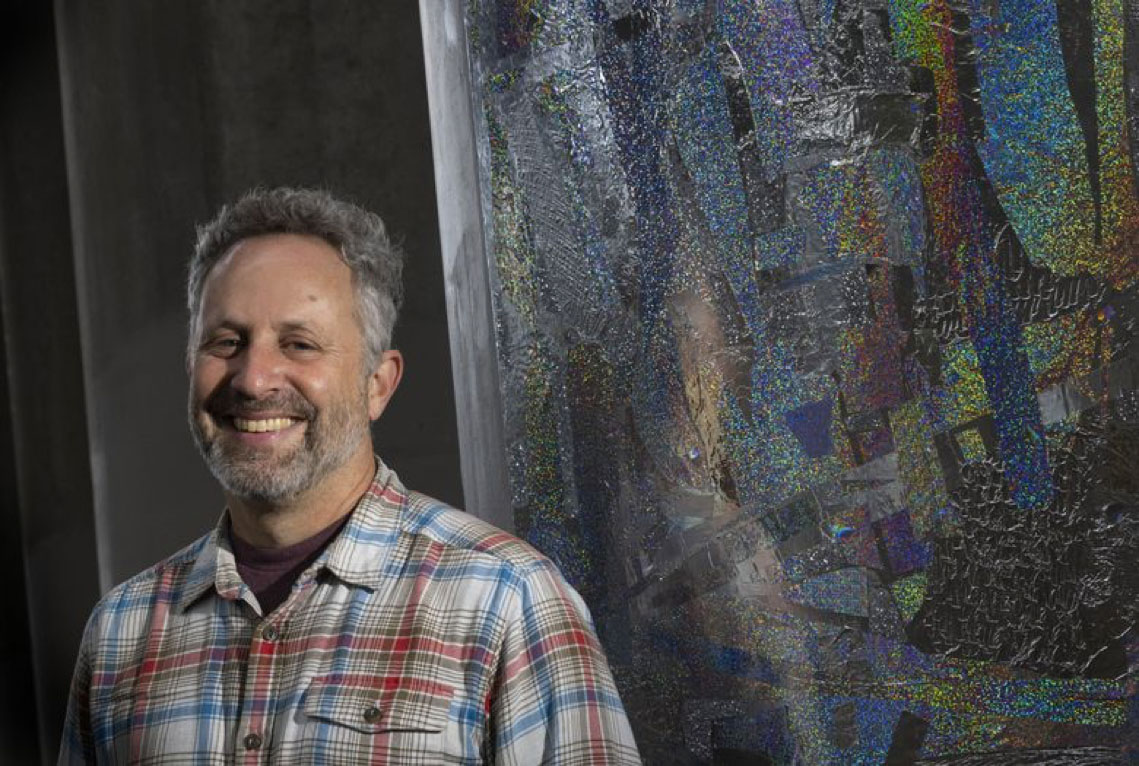
Matthew Offenbacher stands near one of the pieces of art that make up his new show “Charms,” on display under the interstate at I-5 Colonnade Park through Nov. 17. (Ellen M. Banner / The Seattle Times)
‘Hidden gem’ Seattle park is the surprising home of this art show
by Margo Vansynghel
Seattle Times staff reporter
The first thing you notice about Seattle’s I-5 Colonnade Park is the light. Or lack thereof: On a clear October morning, the freeway nearly 100 feet overhead eclipsed the sky, leaving only slivers of blue. Next, you hear the unrelenting roar of cars thundering to their destinations.
This small, somewhat dim park under Interstate 5 is a surprising place to encounter art — especially a cluster of iridescent collages that shimmer like dazzling kaleidoscopes.
With “Charms,” an outdoor art exhibit on view through Nov. 17 in the Colonnade Park between Eastlake and Capitol Hill, Seattle artist Matthew Offenbacher hopes to offer a sense of magic in our gray day-to-day.
“What I’m trying to think about is this question: What is art in the world?” Offenbacher said, standing in front of a shiny, flat collage affixed to one of the park’s massive columns. “What is this power?”
His premise: By jolting us out of our everyday stupor, art has spellbinding abilities.
Facing one of his seven “charms” — made from overlapping sheets of thin holographic and dichroic film, aluminum foil, duct tape, chocolate bar wrappers and glitter — Offenbacher’s theory suddenly springs to life. As if divinely ordained, a ray of morning sun broke through an opening in the concrete ceiling and spotlighted the collage, which transformed into a glittering rainbow.
While multihued in the right light, these artworks aren’t intrinsically colorful — the film Offenbacher used isn’t pigmented. The colors come from the light it refracts at different angles, like dragonfly wings or scratch-off lottery labels.
And like delicate insect wings, these pieces look vulnerable amid the concrete. The overpass largely protects the artworks from the rain, but Offenbacher also potentially exposes them to risks like tagging, theft or destruction.
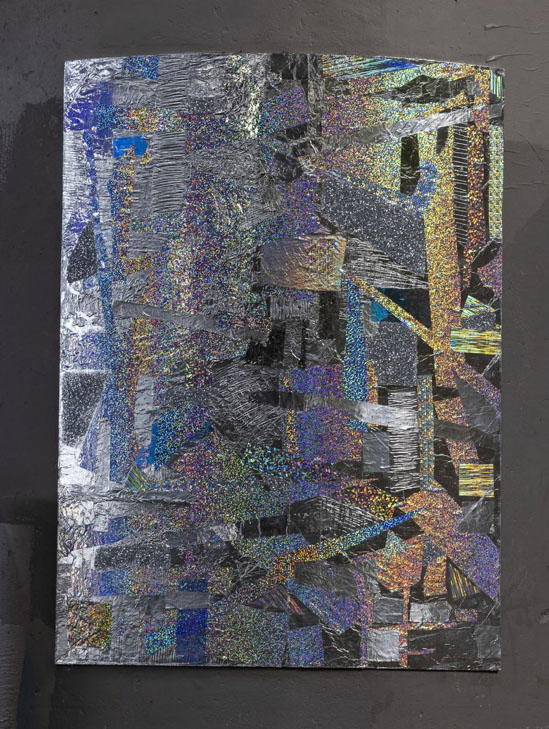
The seven pieces in Matthew Offenbacher’s “Charms” are made from overlapping sheets of thin holographic and dichroic film, aluminum foil, duct tape, chocolate bar wrappers and glitter. (Ellen M. Banner / The Seattle Times)
“I think these are probably getting touched a lot,” Offenbacher said. “This is not a precious art environment.”
There are no gallery assistants or guards to say “hands off,” no glass frame or velvet rope — but that’s part of the point.
By making these works literally unguarded in a place that has at times been a haven for graffiti and tents, Offenbacher’s work is a pointed commentary on what we choose to “protect,” and a call to focus on those who are vulnerable and overlooked as the city plows ahead at mind-bending velocity.
“Haunted” beauty
A longtime local artist-curator and community organizer, Offenbacher is no stranger to unique art projects with a political bent.
In 2015, he and partner Jennifer Nemhauser used Offenbacher’s $25,000 prize money from the notable Neddy Artist Award to purchase artwork with queer and feminist themes by local artists. The couple then donated the works to the Seattle Art Museum as part of an artwork-meets-institutional critique titled “Deed of Gift,” meant to highlight how certain groups have long been underrepresented in major art museums and collections.
For his performance “Feelings (a work in progress),” he added a rock musician and a bystander intervention trainer to a lineup of dancers exploring threads of connection between art forms deemed “classic” (rock, Greek sculpture) with ideas of power and supremacy.
“Charms” is Offenbacher’s first solo show since 2019. For the past few years, he’s been working on these collages in his Sodo art studio. On one of his many walks through the “hidden gem” park, a 7.5-acre forest of hulking columns under the freeway, it clicked. He’d show the new works right here.
“The space has a really intense energy,” Offenbacher said. “It feels a little haunted.”
But with its winding paths and trails, it’s also beautiful — especially when sunlight manages to break through the elevated roads at just the right angle, like a Stonehenge for city dwellers.
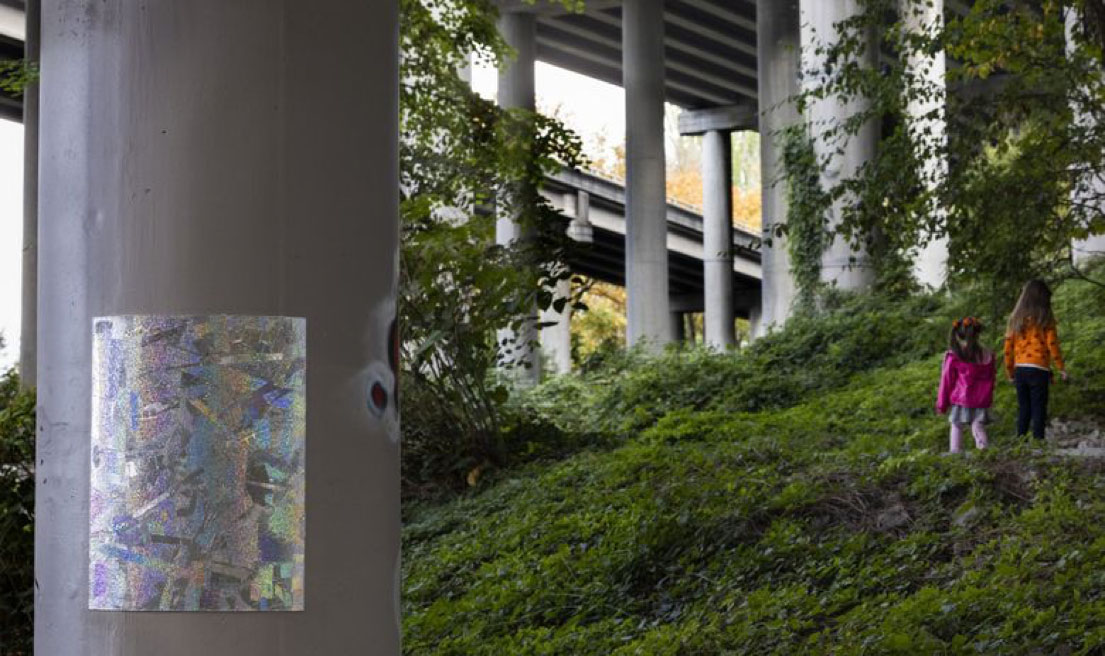
Two girls walk past one of Seattle artist Matthew Offenbacher’s “Charms” last month. (Ellen M. Banner / The Seattle Times)
Offenbacher was also intrigued by the park’s layers of history, which he traced from precolonial times all the way to the 1960s, when the new freeway displaced local residents. In more recent times, the park became a refuge for mountain-bikers, dog-walkers, homeless people and graffiti artists, who tag the columns regularly. The city frequently paints over the tags.
Offenbacher got permission from the Washington State Department of Transportation (which maintains the columns) and city of Seattle (which operates the park) to hang his art. But he likes that his work is, as he put it, “in conversation” with the graffiti that surrounds it.
To Offenbacher, this evokes interesting questions: Who is authorized to occupy public space? Like his artworks, who is exposed to the elements? Who is safe?
In this way, “Charms” is also a critique of the city’s sanitation of public space by buffing graffiti and “sweeping” vulnerable people.
“I think it’s a tremendous waste of money that could be actually going towards people and things that people need in order to survive in an increasingly expensive city,” Offenbacher said.
(A spokesperson for Mayor Bruce Harrell said “the difference between art and vandalism” is consent and touted the city’s investments in new art projects and graffiti abatement. The spokesperson also pointed to “record” funding to address root causes of homelessness and lauded the efforts of the city’s Unified Care Team to “improve the lives of those living unsheltered and restore public spaces for their intended use.”)
Offenbacher hopes his “Charms” cast the kind of spell that nudges people to think about their relationship to public as well as personal safety.
“When do they feel safe?” he said. “I hope it brings that up for people, too — and that’s the magic part.”
“Charms”
4 a.m.-11.30 p.m. daily through Nov. 17; I-5 Colonnade Park, 1701 Lakeview Blvd. E., Seattle; free; accessibility details and map: helloari.com/~matt/charms.htm
Margo Vansynghel; Margo Vansynghel is The Seattle Times arts economy reporter.

June 24, 2019
A White Dude Explores Supremacist Ideologies Through Dance and Aerosmith
by Jasmyne Keimig

Mid-performance shot of Matthew Offenbacher (seated) and his dance crew at “Feelings,” his show at Oxbow. All photos by the author.
Last Saturday, I arrived at Oxbow during the intermission of Matthew Offenbacher’s “Feelings (a work in progress)” performance. I was ill. Positively congested beyond (almost) all reasonable means. I hadn’t wanted to leave my house on that bright sunny day but I felt compelled and deeply attracted to the brightness of Offenbacher’s paintings. So much so I needed to see them in person.
While I knew a performance was going to happen, I wasn’t quite sure what it entailed. In the space, around 30 people were milling about, sitting down, chatting—most were white (the performers and the audience members), because, in this context, I do think it matters.
Eventually, a man in cowboy boots, jeans, cut-off flannel shirt, and a cowboy hat sat down in a chair close to the audience, his acoustic guitar in hand. Five dancers (Elby Brosch, Alex Leydon, South, Jeremy Steward, and Offenbacher himself) shuffled into the space in front of the audience that’s lined ceiling to floor with the colorful figurative paintings. Milky Burgess, the man with the guitar, strummed the opening chords of “Creep” by Radiohead. And then the performers were off.
For the next half hour or so, the five white performers did a series of very carefully constructed dances that call on classical Greek poses and myth to the tune of classic rock. The audience was treated to a survey of the best in white dad rock courtesy of our troubadour and master of ceremonies—“Fat Bottomed Girls,” “Sweet Emotion,” “Freefalling” were welcomed equally.
The performance comes after a month-long residency Offenbacher had at Oxbow, exploring the link between “ancient Greek iconography and supremacist ideologies” and “the strangeness of whiteness and maleness.” The backdrop to this dance was composed of 80 to 90 large vertical paintings based on the ancient Greek romance novel Daphnis and Chloe, which is about a naive shepherd and goatherd who fall in love and live in boundless happiness.
I went for the paintings but ended up being treated to a meditation on whiteness by white people. There were lots of reserved smiles to go around.

A painting from the wall.
Let’s first start with the artwork. I was drawn to the lush, vibrant colors of the large paintings. Offenbacher told me he painted them using cheap acrylic paint that’s sold by the gallon and cut with chalk, which gives the colors this tangible, flaky quality. They have an energy that is playful and sensual, depicting dreamy scenes from Daphnis and Chloe. Their curation warmed up the rather cold space (think high windows, concrete floors, metal beams)—my mind flashed to the rugs hanging from the walls in The Favourite, like if I leaned on the paintings, they'd feel soft.
But back to the dancing.
A stack of paper available at the entrance had basic information about the performance. At the top, a question: “What does it feel like to have power that’s taken for granted, and then to lose some of that power (both by giving it away and having it taken)?”
I was confused by this question—when posed to me (holding down all the identities I do), it lands differently. It seemed to attempt to address white people, white history, and white supremacy. I sat with this thought while watching the rolling, the posing, the deconstructing.
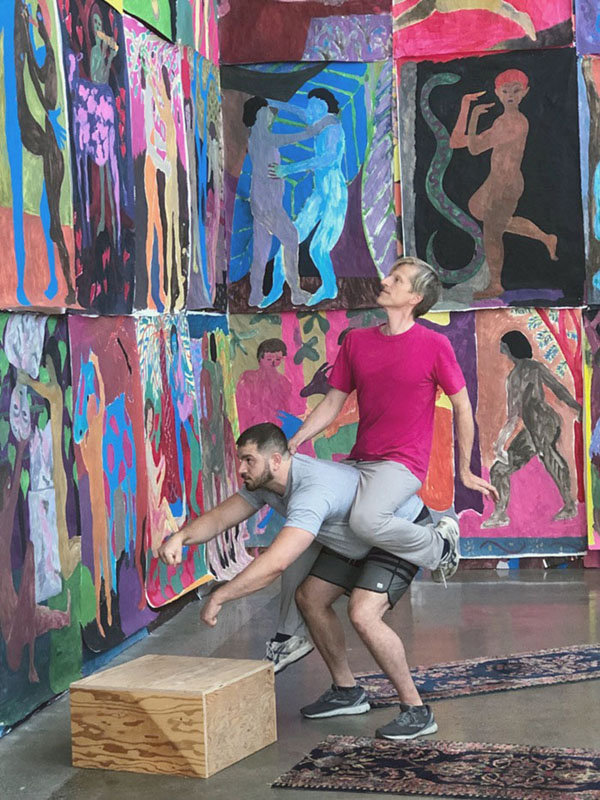
Two dancers posing.
I wouldn’t call what the group did on stage a cohesive, structured “dance.” It was closer to a series of movements—sometimes playful, sometimes serious—generally split into three different movements. The first consisted of each dancer doing a solo pose that was inspired by the figures in the paintings they were surrounded by. The second movement was identical to the first, but done in groups.
The third was the most complex. One dancer would assume a pose from a pile of pictures of classical Greek statues and stand on a podium. The other dancers would sit and admire, then one would stand up, prompting everyone else to, and together they’d awkwardly take down the living “statue,” high-fiving in a way that seemed to rejoice this toppling over.
“This last movement came from videos and images of crowds pulling down Confederate statues. In rehearsal we ended up watching a lot of different statue-toppling videos from all over the world,” Offenbacher wrote to me in an email recently. “The ritual we did afterward (the rushing out and in, waiting for the statue to relax, then high-fiving twice) came from abstracting celebrations we saw in these videos.”

Offenbacher posing on a pedestal
So, while watching the performance, this knotty (and kind of shaky) connective tissue between classic rock, classical Greek iconography, and their relationship to whiteness began to emerge. Both bear the name “classic.” Both have been used as a way to exclude and support supremacist ideologies: from mythologizing whiteness to alienating the black community (and women) from a genre of music they created.
By using only white performers, Offenbacher said that he hoped to signal “the idea that anti-racist work needs to be done within white communities, especially around building knowledge about white culture.”
Despite the seriousness of the language surrounding the performance, it was actually quite playful. Most of the poses were silly. Sweat was shed. Offenbacher often had a giant grin on his face. We had a troubadour. There was an offhandedness to it that drew me in, attempting to figure out exactly what the performers were trying to achieve.
And that question! Offenbacher told me that the desire to do this project came from him recognizing that as a white cis man, he’s had more resources to draw on because of his identity.
My predecessor Jen Graves wrote in 2015 about how Offenbacher took $25,000 in art prize money and bought work from queer/women artists. He then donated these works to the Seattle Art Museum, citing the lack of art in their permanent collection done by artists with queer and women artists.
“In this project, a moment of clarity came for me in watching the horror show that was the Kavanaugh hearings, and especially witnessing his anguish at having his power challenged, even just for a moment, and ultimately without consequence,” he wrote to me.
Continuing, “The feelings that he embodied in the hearing with his crying and belligerence are the feelings that my title is referring to. If we are ever going to move beyond white male supremacy, white men have to start examining and dealing with these feelings in honest ways that don’t cause harm.”
This is all well and good. There was nothing offensive about the performance at all, but I questioned my place there. While the rise of Tr*mpism illuminated a lot of the injustices and violence of whiteness for white people, this isn’t new knowledge to queer communities and communities of color. The system isn’t broken, but working as it should. And while Offenbacher’s careful and purposeful examination of whiteness is interesting, I’m not sure if it was for me (literally!).
I left Oxbow thinking about those paintings though. They kept me company on the long bus ride home.

February 2, 2019
Hot take! Hume’s Tomb/A Sharper Image by Matthew Offenbacher at cogean? Joey and Ben graciously let this introvert come to the opening early and fed me a chicken sandwich. As I watched Offenbacher’s Hume’s Tomb video of Trisha Brown’s repeated movements accompanied by the Grateful Dead’s “Uncle John’s Band,” the loving conversational patter between the artist/couple also played in the background. The lyric, “Woah, oh, what I want to know, is are you kind?” seemed especially related to the total environment Joey and Ben create for the work they bring into their home. Released in 1970, that lyric might be a reference to the unrest at the 1968 Democratic Convention and the stabbing at the Altamont Speedway Free Festival in 1969. The question everyone was asking of each other then is just as relevant now.
Offenbacher’s weaving together of Enlightenment philosopher David Hume, tech history, its role of it in the Pacific Northwest, and orca whales is a puzzle I haven’t quite fit together yet but appreciate the opportunity for expansive inquiry into seemingly unrelated elements of PNW culture. “It’s a kind of ultra-capitalism that invents algorithms to orchestrate global flows of goods and services,” Offenbacher said of the Puget Sound region in an interview on the cogean? website. (Recommended reading!) Look for Offenbacher’s puzzles on ferries on your way over and check the website for upcoming puzzle parties or to purchase one.
—Katie Kurtz
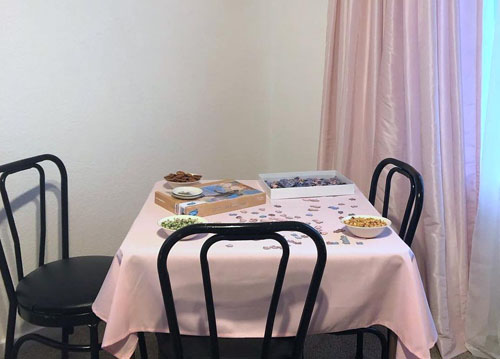

Painting’s Not Dead
December 8, 2016
by Margo Vansynghel
The debate about whether or not painting is dead has continued, with sweeping declarations, for almost 200 years now, yet here were are, surveying American Painting Today. This is the lofty title of a new exhibition in the V2 space on Capitol Hill (opening with a party tonight), hoping to prove that painting is alive and kicking in Seattle.
More than a hundred paintings are hung salon-style across the striped walls of Capitol Hill’s former Value Village, which is living its last days. At the end of this month, the auto row-era building will be redeveloped into office and retail space and the temporary art space there will close. The current walls will not survive—yet for the exhibit, it all started with those off-white wooden walls, formerly hung with second-hand treasures of a newly forgotten past. “The walls are so specific to this place,” says exhibition organizer Matthew Offenbacher. “I thought they would make a visually interesting background for a huge painting exhibit.”
He continues, “Seattle is not often thought of as a great city for painting. I wanted to show the variety of amazing painting that’s being made here.”
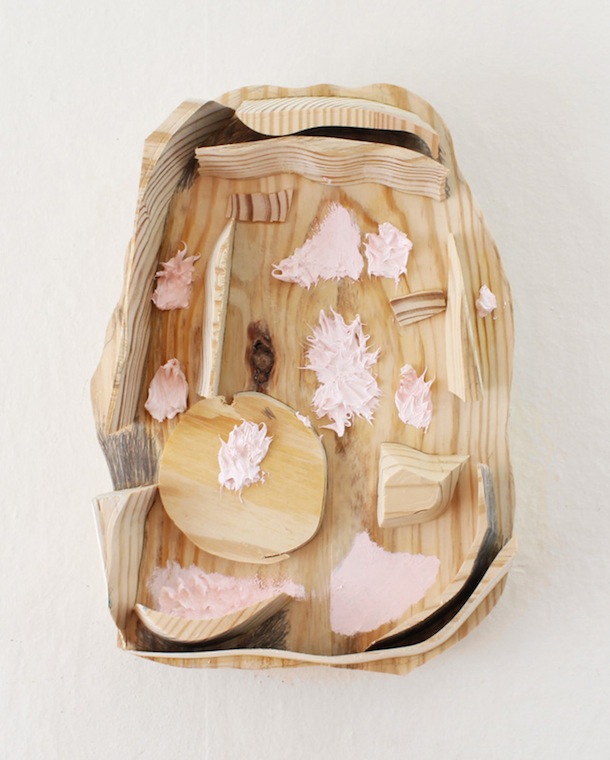
Tuan Nguyen, 'SuGaR,' graphite pencil, oil paint, wood, 14.5 x 10.5 x 3", 2015.
The array of works, in various gradations of abstraction and three-dimensionality, is impressive. Take Emily Gherard’s modest-sized graphite-and-staple painting, tucked away in a corner, or Robin Green’s found cookie sheet, which doubles as a canvas and holds a dried-out, wrinkled white fabric, in turn a background for ink spatters. Julie Alexander uses repurposed fabric to hang her painting, titled “My Ankle Your Foot,” with drapes, like a window. Next to that, two brightly colored wooden bowl-shaped assemblages by Tuan Nguyen are painted in bright colors and dotted with curious sculpted shapes, like sawdust teeth or cotton candy paint drops.
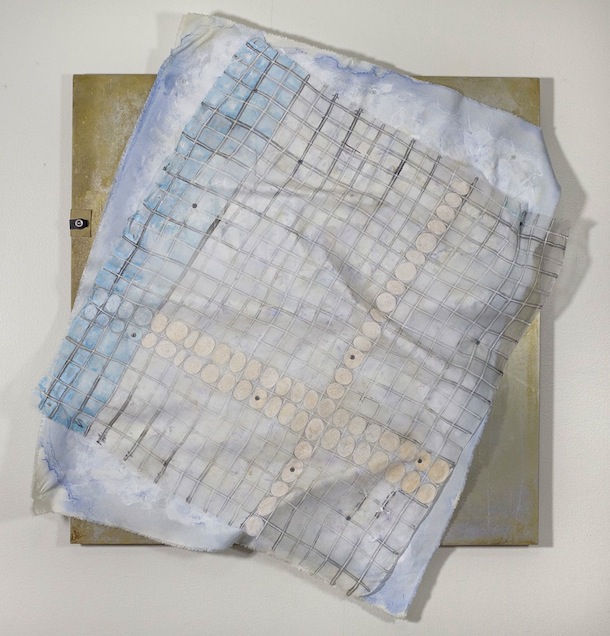
Robin Green, 'baked white,' silks, acrylic, ink, found cookie sheet, rivets, 11 x 15", 2016.
Among the 94 artists included, many seem to take the word painting lightly. That’s a good thing, certainly when Philip Miner does so, with his “Profit, Cher Prophète,” a four-panel ink-jet print on fabric, or Neal Fryett, who used photographic prints clipped to sheets of Arches paper. There are plenty of local luminaries such as Ryan Molenkamp, Francisco Guerrero, Kelly Bjork and Joey Veltkamp (A horse! A rainbow! It’s exactly what the show needs.)
When Offenbacher invited artists to the show, he also asked them to suggest other artists. Every suggestion made it into the exhibition. In the end, he included work from artists he didn't know at all.
“It was a good way to reach beyond my own circle,” Offenbacher says. He prefers the epithet “organizer” instead of “curator;” for him, the curating was done by the artists. “A curator would have never left so much of it up to chance. That’s why there’s a certain randomness to it. Also: I didn’t plan it as a comprehensive survey.”
American Painting Today is an ambitious title for an exhibition we shouldn’t consider a comprehensive survey, but given Offenbacher’s humor, it comes with a wink.
“If the Whitney Museum in New York organizes a show by the same title, with mostly local—New York—artists, people are totally fine with it,” he says. “The title is a commentary on how local art is marginalized compared to art made in places like New York or Los Angeles.”
Offenbacher, himself a painter, has long explored institutional framing and the power divide between the individual and institutional through writing, actions and exhibitions. Among his recent projects is Deed of Gift, for which he used the $25,000 prize he won from the Neddy Artist Award in 2013 to buy local art with feminist and queer themes to donate to Seattle Art Museum. But the presidential election has left Offenbacher’s context charged: The title and the show became something less ironic and more earnest. Can a group of artists, and by extension American society, come together as a community?
“For me, the social interaction is as important as the paintings,” Offenbacher says. “This show is mainly an attempt at community-building.”
The day a dozen volunteer artists came together to hang the work, Offenbacher didn’t decide precisely where the paintings should go. He instead eschewed traditional curatorial input by presenting artists with an intake form comprised of seven symbols—sunset, mushroom, triangle—and invited them to select the ones they felt related to their work. Later, works were clustered based on chosen symbols.
In these hostile times, American Painting Today should take pride in its literal inclusivity. However, the show’s greatest strength may also be its greatest weakness. A curator’s firm hand might be what this exhibition needed, to group works and filter out lesser paintings. At the same time, the overdose of styles suggests that both painting and community-building are nowhere close to dying. It's also a reminder that, despite sentiment to the contrary, this will likely not be the last time we’ll be overwhelmed by a staggering amount of art in this hyper-developing city.

“American Painting Today”
Editors’ Roundtable
Column by Matthew Kangas
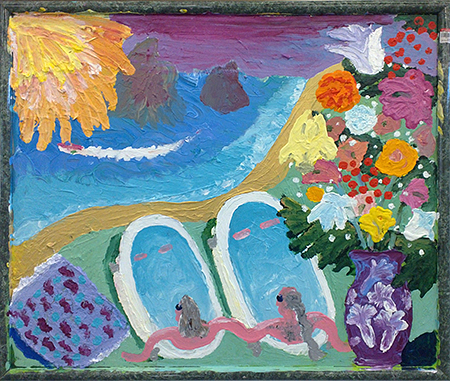
Forrest Perrine, "Finger painting w/Cialis, vase and speedboat," 2016, acrylic on found frame
Periodically, Seattle’s art community stages its own exhibits, usually to make a point about being ignored by local art galleries and museums. “American Painting Today” is set up in an abandoned Value Village charity thrift shop on Capitol Hill [located at 1522 11th Avenue through December 17th—Ed.]. The results of such an undertaking are necessarily mixed. In this case, 39 well-known artists share the grungy space with 54 virtual unknowns. Matthew Offenbacher, the self-appointed juror, invited a number of friends who then invited other friends — all of whom were free to send whatever they wished, one or two paintings each. Nothing was really curated or selected; nothing was rejected. Adamantly denying he is a curator, Offenbacher nonetheless deserves the credit (and some of the blame) for bringing together area artists who are committed to the medium of painting at a pivotal time. Conceptual artists were unsuccessful at killing painting; with its two-dimensional surfaces open to social and political imagery, painting has become more relevant than ever.
Displayed salon-style in tiered rows on three long walls without any labels or prices, selections are seen under crowded circumstances that make it more difficult for abstract or minimalist pictures to be seen to their best advantage than for figurative or representational works. Because of the artist-referral method and artists’ self-curating, viewers’ responses will hinge on whether they have prior or no familiarity with a given artist. “American Painting Today” (even the title is a sly joke) is a modest, hometown effort, but one with considerable pleasures and delights among which are interspersed disappointments. How could it be otherwise? Quality control is replaced by lots of good will.
Among the figurative-narrative painters, Forrest Perrine’s “Finger Painting with Cialis, Vase and Speedboat” is the funniest, a crudely painted scene lifted from the erectile dysfunction TV ad with a man and woman in side-by-side bath tubs. It joins other folk-art-like entries, including works by Joey Veltkamp, Shaw Osha and Denis Fitzpatrick. Painted in the same vein, but more formally complex, “Fixated” by Barry Johnson is a tumult of hurtling figures in a crowded consumer environment.
Sobering images that play into the new artist-as-Cassandra trend, paintings of prisons by Buddy Bunting stand out, as do ecological warnings by Nathan DiPietro (“Rain Columns at Sunset”), Helen O’Toole (“Shelter”), Laura Hamje (“Scorched Earth”), Timothy Cross (“Rain”) and Ryan Molenkamp (“Fear of Volcanoes #80”).
Textiles and recycled or newly knit fabrics comprise a whole mini-section that is filled with considerable promise, offering a fresh perspective on painting’s links to craft. Indeed, during conceptual art’s heyday, painting was referred to as the “sixth craft” after clay, glass, fiber, wood and metals. Among these artists, Paul Komada is by far the most interesting. His “Obviously Covered and Masked” is a zany combine of argyle sweater fragments and a see-through canvas on its stretcher with matching painted sweater pattern. Margie Livingston also deconstructs painting. Her stretched canvas faces the wall, a relic after a performance in which she dragged the painting on her back, weighed down by rocks attached to a string. The historical burden of painting? “Pink Panther” by Sean Barton uses pink satin and fringe as a base for a faint black inkjet image. Nicholas Nyland’s “Soft Painting” further undermines traditional definitions with its odd ceramic add-on. Linda Davidson expropriates a bedspread upon which to paint.
The younger, mostly as yet unfamiliar artists, many of whom have moved to Seattle after attending prestigious art schools back east and elsewhere, provide some welcome surprises. Sasha Ferré, Doug Parry, Andrew Rubinstein and Michael Ottersen show promise of great things to come.
Among my critic’s choice “award” winners are a timely “Tribute to Betsy Ross #6” by Ray Mack that channels Larry Rivers; Sasha Ferré’s remarkable painting of the artist taking her own selfie (it obscures her face); “Where Did You Sleep Last Night?” by Victoria Haven, a black-on-black evergreen tree scene commemorating the homeless; Julie Alexander’s “Duet,” an ethereal abstraction of acrylic on see-through organza dress fabric; and I want to see more of Francisco Guerrero’s dark, moody landscapes such as “At the Cle Elum River — Northwest Gothic.”
Finally, abstraction, another recent survivor of assassination attempts, shows every sign here of recovery and revival. Older stalwarts like Lisa Buchanan (“Tailspin”), Ken Kelly, Harold Hollingsworth and Susan Dory are joined by David Hytone, Julie Alexander, Sue Danielson and Margaret Watson. Given the cruelly crowded hanging and riot of recognizable imagery surrounding them, these artists nonetheless provide an encouraging respite, all the better to assist in contemplating the bright, next future of painting.

December 5, 2016
American Painting Today: A High-Falutin Thing in a Precarious Place
by Jen Graves
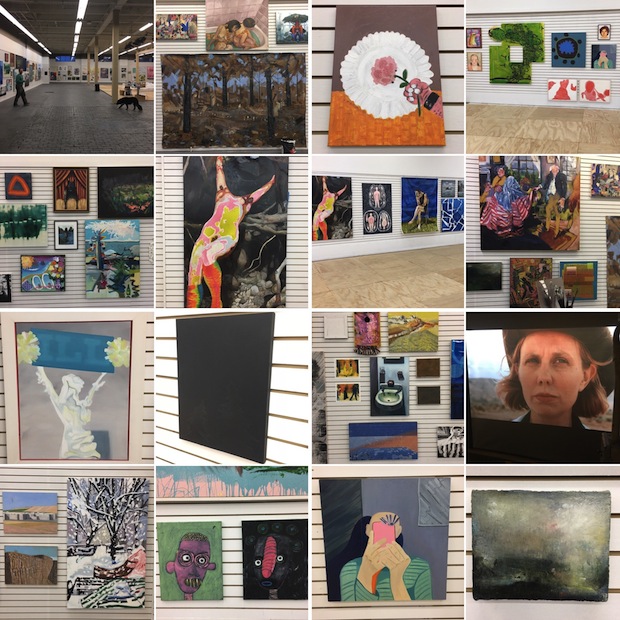
Yeah, I took all those pictures and cobbled them together. And there are plenty more where those came from, at V2 starting December 8. JG
American Painting Today is a great big exhibition with a very official-sounding title. But the grandiosity, on paper, of an exhibition of 120 paintings by 90 artists, is exposed as something else: a precarious undertaking about to be wiped away, like the dusty, ugly Value Village store that used to be inside this same space on Capitol Hill. Artists have taken over this space and called it V2 for most of 2016. Now they'll have to leave, and the building will be redeveloped into something more expensive and more exclusive.
Seattle artist Matthew Offenbacher organized the show (which is sponsored by Hedreen Gallery) by inviting painters, who then invited other painters. The artists sent him what they planned to show, and then many of them turned to darker, more difficult pieces after the election. Coming together this way, they form a community-building exercise that also turns out to be a strong survey of the vast range of possibilities for what a painting can be.
A few standouts from the tile of 16 pictures above: Mark Takamichi Miller's terrible flayed woman based on a photograph he found online (see Rembrandt's famous flayed ox from 1655); Sasha Ferré's droll selfie portrait Me (I Mean You); the pairing (at the very bottom left) of Susanna Bluhm's snowy candy-city landscape with Buddy Bunting's desert prisons; Francisco Guerrero's grotesque Lady Liberty/cheerleader; and next to that (above Bluhm and Bunting), a black-on-black image by Vic Haven reminiscent of the New Yorker's Twin Towers cover, but this time, with evergreen trees instead of towers.
[...]

May 6, 2015
THE MOST UNUSUAL ART GIFT EVER
After Matthew Offenbacher won a $25,000 art prize, he did something radical. He made a conceptual artwork with Jennifer Nemhauser that consisted of buying works by women and queer artists for Seattle Art Museum.
by Jen Graves
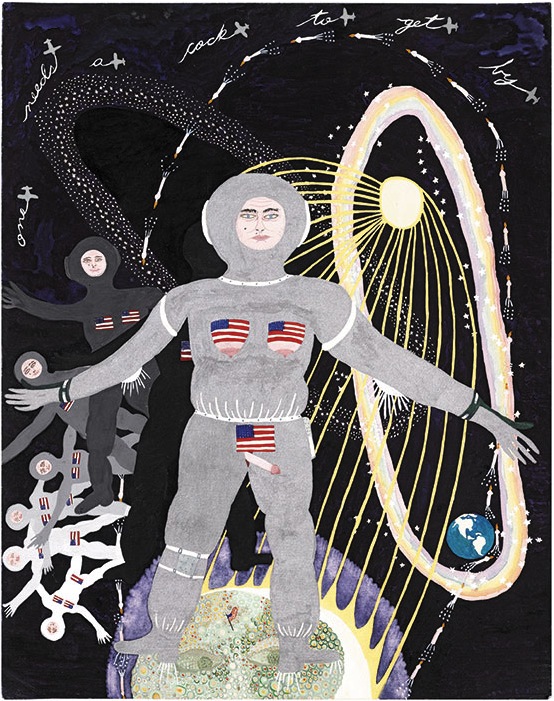
Woman Landing on Man on the Moon by Ann Leda Shapiro. It has never been exhibited before. Now Seattle Art Museum owns it. Images courtesy of the artists and Seattle Art Museum.
When the traveling Elles exhibition came to Seattle Art Museum in 2012 from one of the most respected modern art museums in the world, Seattle encountered an embarrassing problem.
Elles was a big show, organized by the Centre Pompidou in Paris, with more than 130 pieces in it dating from 1907 to 2007. Momentously, it included zero male artists. Women artists alone told 20th-century art history, from Frida Kahlo to Diane Arbus to Marina Abramovic.
As a symbolic gesture, Seattle Art Museum wanted to create a companion exhibition out of its own holdings. The plan was that SAM would empty out the galleries and rehang them entirely with art in their permanent collection by women.
There was just one problem.
SAM’s 20th-century holdings, like the holdings of most museums, are so woman-poor that there was no way to fill their galleries solely with art by women. Private lenders were solicited to step in. SAM’s “collection” galleries temporarily became galleries filled with other people’s stuff.
The point had been to demonstrate how much Seattle’s largest art museum values women. But Elles inadvertently revealed how much it hadn’t.
Among the women artists whose work SAM had never acquired was Ann Leda Shapiro. Shapiro lives on idyllic Vashon Island, the perfect place for an early feminist artist to hide out during the Reagan, Clinton, and Bush years. The last time Shapiro made a splash as an artist was in 1973, when she had a solo show at the Whitney Museum of American Art in New York, her hometown.

Two Sides of Self by Ann Leda Shapiro, which the artist says was censored in the ’70s by the Whitney Museum of American Art. Courtesy of the artist and Seattle Art Museum.
There were two solo shows by women at the Whitney in November of 1973. The other artist was Lee Krasner—an abstract painter who, at that time, was still almost entirely known as a famous man’s wife (that drip-painter fellow, rhymes with “bollock”).
Unlike Krasner, Shapiro is no abstractionist. She’s completely out there with her subject matter. Her 1970s watercolors are feminist and antiwar fantasias, depicting hermaphroditic mermaids with interlocking nipples, fish that look like little missiles, and female astronauts whose penises and breasts are imprinted with the American flag.
When the drawing department at the Whitney invited her to show, Shapiro sent slides, the works were approved, and then she sent in the works themselves. At that point, she was confoundingly informed by the curator that two pieces, one titled Two Sides of Self (the mermaids) and one titled Anger, would not be allowed to be shown in the Whitney because “anything erect was edited out, anything limp was hung, if you know what I mean,” according to Shapiro. (This anecdote may prompt your own extended consideration of whether the female mermaids’ penises are, in fact, erect. They appear to be in something of a middle state.)
In other words, Shapiro’s work was deemed obscene and inappropriate for a fine-art museum. But she took notice the following year when her friend Jim Nutt, a male artist who uses overtly sexualized imagery, had a big exhibition at the Whitney.
At the time of her own show, Shapiro didn’t even think of fighting it.
“I was young and I was shocked, and I just sort of said, oh, I’m lucky the show is hanging, and that was that,” she told me. “I chose not to participate in the art world per se after that, just at alternative spaces or university art galleries. But what I think is important is that I didn’t do internalized censorship. I painted what I wanted to paint.”
An archivist at the Whitney confirms Shapiro’s exhibition in November 1973, but the museum’s files contain no mention of censorship. Nor do the files contain a final list of which works went up on the walls.
After a time, Shapiro turned her studies toward acupuncture and Chinese medicine, moved to Vashon Island, and mostly disappeared from the art world. She kept painting, but Seattle Art Museum, the major art museum in her adopted region, never even knew she existed.
A few weeks ago, Two Sides of Self, the mermaid watercolor, and another watercolor that has never gone on exhibit anywhere, Woman Landing on Man on the Moon, crossed over to the other side—into SAM’s permanent collection.
Now SAM is spending its money and energy protecting these pieces, each no larger than a kitchen cutting board. Shapiro hopes that SAM in 2015 will be willing to exhibit what the Whitney of 1973 would not.
“I hope they hang it on the walls—that’s my concern,” Shapiro said. “I wouldn’t be surprised if they don’t.”
She paused.
“I usually show at the credit union on Vashon.”
The only reason that Ann Leda Shapiro has been inducted into future art history as told by SAM is that Seattle artist Matthew Offenbacher recently won a prize and, together with Jennifer Nemhauser, decided to do something revolutionary with it.
Offenbacher is a mid-level Seattle artist. He’s a painter but also an organizer of artists, and the publisher of a smart, influential zine called La Norda Specialo. His paintings are not included in any Seattle museum collections, but he has been recognized for them. In 2013, he won the Neddy at Cornish in painting, which comes with an unrestricted $25,000 award. An unrestricted award means you can do whatever you want with the money—buy a convertible, blow it on the best beach vacation ever.
But Offenbacher and Jennifer Nemhauser, his partner of 25 years, decided to take the money coming into their household and send it right back out. They bought art by female and queer artists who live locally and they donated it to SAM for the permanent collection.
“It’s a conversation we’ve had for as long as we’ve been together—the issue of who is valued, who gets to be written into textbooks in history,” Nemhauser said. She’s a biology professor at the University of Washington, and has the same questions about science as Offenbacher has about art.
After Elles made painfully obvious just how slim museum holdings are, meetings of Seattle artists were convened, including one called the Seattle Women’s Convention, to ask: What next? What can we do to support women artists better?
Not long after Offenbacher won the $25,000, he sent SAM curators Catharina Manchanda and Chiyo Ishikawa a simple e-mail requesting a meeting. Right away, there was interest. Soon the two curators were in a fifth-floor conference room with Offenbacher and Nemhauser, talking about their idea. Offenbacher and Nemhauser had brought with them a list of 50 artists and works they felt represented the best of local feminist and queer art.
It was, Manchanda said, “the most unusual project in relation to an acquisition that I’ve ever worked on.”
Offenbacher and Nemhauser proposed the whole project as a work of art unto itself, called Deed of Gift. The work is not only the gift of the small collection to the museum, but the process leading up to the gift.
“As a gesture, as a project, as an undertaking, I see it as an extension of Matt’s larger self-understanding as an artist,” Manchanda continued, “and as an artist who wants to make a difference in the local community. I may be overstating it if I say I’m seeing it as an art project, but it felt that way.”
Deed of Gift—there is an actual legal deed documenting the deed that was done—can also be seen as an epic act of kindness.
“What a generous gift,” said Robert Kaplan, a museum trustee who is on the acquisitions committee. (Kaplan is a major collector of Australian aboriginal art.) “He must be quite an interesting person.”
But that’s not how Offenbacher and Nemhauser prefer to see it.
“We don’t like it at all when people say,“‘You’re so generous,’” Offenbacher told me. “The intention of it wasn’t to be generous, really... I’d like it to be understood as an art project that was trying to start conversations and have symbolic value in the community around how artists and artworks are valued, how museums make value.”
“It starts from a hard place,” Nemhauser elaborated. “It wants to bring up really hard things to talk about. Charity is a little different. [Deed of Gift] is not selfless. We’re really deeply invested in our community in Seattle and think there are some hard questions that need to be asked and discussed. This art project is a bit of a prod.”
In other words, giving to SAM was a way of critiquing SAM from the inside.
“I’m not naive, I never would have made it into the Seattle Art Museum,” said Joey Veltkamp, the only male artist of the seven.
His piece that entered the collection as part of Deed of Gift is a quilt, referencing that domestic “feminine” craft, made using fabric that’s patterned with butch plaids and symbols of the rugged outdoors in Montana—plus swatches with bears and squares of fuzzy faux polar-bear fur. “It’s just so damn sweet. It’s just such a gentle institutional critique. Like a hug. Like, ‘Okay, you’re missing some things, so let’s give them to you. That seems to be really hard, maybe this will help.’”
When Manchanda visited Veltkamp for a studio visit as part of her stealth research for Deed of Gift, Veltkamp didn’t know why someone so important was visiting him. He’s a self-taught artist. Being part of SAM’s collection is “shockingly validating,” he said later. It was good at the time he didn’t know the stakes were high, because he figured why not go for it, and he and the curator were able to have a real conversation, he said.

Joey Veltkamp’s Glacier quilt. His version of the domestic “feminine” craft is patterned with butch plaids and symbols of the rugged outdoors.
“She talked about [how] it actually is hard to get work at SAM by women artists and queer artists, because, you know, someone might approach you with money, and you direct them toward a piece, and that money might dry up if it’s a piece by a woman or a queer artist,” said Veltkamp. “It just kind of shocked me that in 2015, that’s still a challenge sometimes.”
(Manchanda said later that she would characterize their conversation differently. As she explained it, “Some people are drawn to things that are more classic—to, say, key moments in the history of art—and then others want to be politically engaged.” Manchanda added that she “would personally love to build the legacy” at SAM in feminist work and conceptual art of the 1960s, two areas where SAM’s collection is thin.)
SAM does not keep tabs on the gender breakdown of its modern and contemporary art collection, according to a spokesperson. But upon request, SAM was able to tally how many works by male and female artists the museum has acquired in the last two years for its modern and contemporary collections, which cover the 20th and 21st centuries.
In that span, SAM acquired 221 works total: 35 by women and 186 by men.
It’s difficult to come to tidy conclusions about a project as complex as Deed of Gift, but one sure thing is that Deed reveals how much unseen power and sway people with money have over what the museum decides to preserve for posterity.
This should come as no surprise. Almost every art museum in this country was founded by a rich man giving over his rare, expensive stuff. The family gets the windfall from the tax break for donating, and the public gets culture, so it’s a win-win.
But science was always part of the picture, too. Museums are meant to gather together artistic experiences and assess them in a comprehensive way that no single person’s taste could. They are meant to write history, to be factual. They classify art by breaking it down into time periods and geographical regions and styles, and those styles are understood as more than mere fashions—they reflect back the larger world from which they derive.
The professionalized, academically based, quasi-scientific, yet popular art museum—the American art museum as it stands today, like Seattle Art Museum—is crawling with conflicts and paradoxes that never overtly make it into the galleries. Those are the heart of Deed of Gift.
Seattle Art Museum is a private entity, but with that name, it sounds like a public agency. As a civic symbol, it ought to reflect the entire city and not just an elite slice of it. Offenbacher and Nemhauser chose SAM rather than the Henry Art Gallery or the smaller Frye Art Museum for that reason. What SAM owns in some senses the city owns. If SAM supports women artists, then this particular city is a comparatively good place for women artists.
“Giving work to a museum is automatically made to be a charity act,” Offenbacher said. He’s getting heaped with praise for being a donor. But, he said, like it or not, “collectors and donors should realize they have much more of an influence” on the city and the museum than they might think. And with power comes you-know-what.
There is a bright side to the arbitrary way that a single donor can make a difference. Someone with money who wants to help round out a museum collection simply “has to put a stake in the sand,” said Josef Vascovitz, a wealthy Seattle donor.
Vascovitz and his wife, Lisa Goodman, donate almost exclusively art by artists of color to SAM. Somebody has to do it, because the museum has very little budget for any new art, let alone artists who aren’t household names. The art-going public still prefers Picasso, Matisse, and the impressionists. Donors can intervene to provide balance in the permanent collections.
“If you say ‘feminist artists’ or ‘black artists,’ even if those artists are offering their commentary on landscape, you scare museum-goers away,” said Vascovitz, who was on the acquisitions committee that approved Deed of Gift.
“It’s one thing when Lisa and myself give, because everybody assumes we can and should,” said Vascovitz. But when people like Offenbacher and Nemhauser take “their very limited resources and use them as a multiplier effect like this? It’s exceptional, and I don’t use that adjective lightly.”
Offenbacher and Nemhauser have an agreement that they check in with each other any time either of them wants to spend more than $100. She recalled how this time he described his idea over dinner, and Nemhauser “basically said, ‘Wow, you have such an awesome brain—I totally want to do this with you!’ It was really that simple.”
By contrast, “This time of year, we spend a lot of time... debating about how many bunches of asparagus are reasonable versus pure decadence.”
Klara Glosova, another Seattle artist whose work is entering SAM’s collection thanks to Deed of Gift, has always made art from her everyday. She has teenage sons who play soccer. A lot of soccer. For Glosova, this means many hours spent on the edges of sports fields, the edges of her sons’ heartbreaks and triumphs.
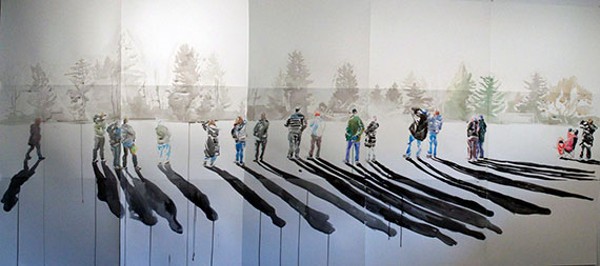
Klara Glosova’s Life on the Sidelines. From a series of giant watercolor-on-paper paintings, this one was recently acquired by SAM.
Last year, Glosova made something of a departure from her more typical ceramic sculptures of everyday objects—dirty socks on the floor, for example—by creating a series of huge, gorgeous watercolors on paper called Life on the Sidelines. The paintings depict, over and over, rows of parents on the sidelines of athletic fields. The parents cast long shadows, and nothing is happening on the field. You never see faces, only backs.
Last month was the first time Glosova had ever been behind the scenes at SAM. She is used to showing work in galleries and DIY spaces. When Glosova brought the watercolor SAM had acquired through Deed of Gift, it was treated with a reverence she’d never experienced before. “Nobody wanted to touch it, and they asked me to slide it off the cardboard,” she said. “It was like it crossed over to another place that’s very unfamiliar to me.”
While she was there, she noticed the freight elevator was so big and beautiful, she encouraged them to put on shows there.
As for how it felt watching her art entering SAM’s collection, she talked about it like a parent giving away a child. “Somebody else will take care of it much better than I ever would,” she said. “That’s huge for an artist.” Being part of Deed of Gift “kind of seems like the best thing that could ever happen to an artist.”
Offenbacher admits with a smile that the path Glosova’s painting took to get into SAM’s collection was “extremely nonlinear.”
“We started with a very naive view,” Nemhauser said.
“We didn’t realize how much of a political process it is,” added Offenbacher.
Don’t forget that Offenbacher and Nemhauser started with a list of 50 artworks; Deed of Gift ended up consisting of seven total. As for what didn’t make the cut, all the specifics of the conversations between the donors and the museum are confidential. Nemhauser explained that artists in Seattle are told often enough that they’re inadequate that they don’t need to know they were on the losing end of yet another competition for scarce resources.
But it sounds like the curators and Offenbacher and Nemhauser really hashed it out. “Those conversations were substantive,” Nemhauser said.
At first, Nemhauser wanted to donate more obscure pieces. “That doesn’t fly at all at a museum,” she learned. The museum wants an “iconic” piece by Wynne Greenwood—one of her nationally known videos, for example—not one of her soft sculptures. Greenwood’s signature 2007 video YOUNG WOMAN WARRIOR PREPARED FOR BATTLE was selected for Deed of Gift.
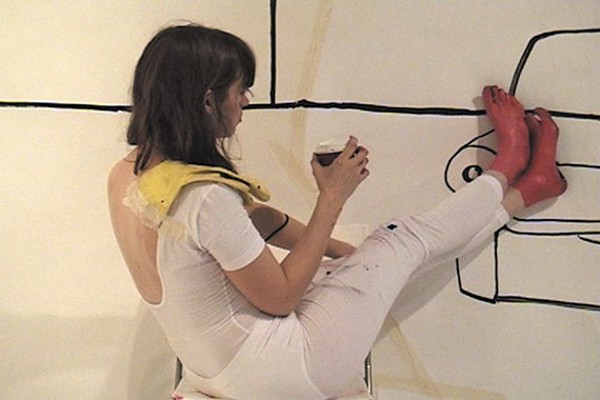
Wynne Greenwood in one of her signature videos, this one titled YOUNG WOMAN WARRIOR PREPARED FOR BATTLE, which was just acquired by SAM.
Over the course of months of e-mails, phone calls, meetings, and studio visits, there was horse trading. There were times when the curators came back from the director’s office with changes. Offenbacher and Nemhauser never met the director or any board members. “The idea of ‘women’s experience’ came from the museum, and ‘feminist and queer thought’ was coming from our side,” Nemhauser said. “So—those met.”
Nemhauser and Offenbacher both laughed, and she said, “It’s politics, right? Museums are intensely conservative. It’s more clear to me now why holes that everybody can see and point to don’t get filled over time.”
In the end, Offenbacher and Nemhauser spent $16,800 directly on the art. They estimate they spent about $20,000 total on Deed of Gift, including various expenses, paying themselves an artists’ fee, and a planned party. The artworks cost from $5,000 down to $6 for a chapbook by Anne Focke, who emerged in the 1970s by founding the interdisciplinary center and/or, and went on to become a legendary Seattle artist/administrator.
The curator Manchanda argues that Offenbacher continues Focke’s legacy. “She redefined artistic practice at an earlier time,” said Manchanda. “She writes, ‘the patterns I make, the work I do, is functional like a container... not simply a container for something else. A form-er.’”
Likewise, Deed of Gift is functional like a container, and it forms something new.
And think about this: Offenbacher, the original instigator, is the only artist in all of this who does not have art in SAM’s collection. One issue of his zine, containing an excellent essay he wrote about Northwest artists titled “Green Gothic,” is held in SAM’s library, which means that when Manchanda searches for “Offenbacher” in SAM’s internal system, she at first thinks he is officially included in the permanent collection, then no, then maybe, and finally: no.
“That really pleases me, that my status in relation to the museum is confusing,” Offenbacher said, in his calm, gentle-voiced, nonconfrontational way. He sounds curious. He always sounds curious.
The only work of art SAM did not acquire is Deed of Gift itself. That belongs to Offenbacher and Nemhauser, and they’d be willing to sell—but the price is $25,000, which they would turn around and spend the same way, on more art for a museum.
On April 21, SAM hosted a party for the donors of all recent acquisitions. There were drinks and hors d’oeuvres, and most of the people were in fancy dress, suits and ties. This was the final “window into how SAM does things” that Offenbacher and Nemhauser got. Artists were also invited, and all sat together at one table. No seats were assigned, but the tables ended up divided by role anyway: donors, artists, museum staffers.
Seattle artists Dawn Cerny and Victoria Haven were there. They collaborate under the pseudonym Daft Kuntz, a name that’s a play on “cunts” and kunst, the German word for “art.” Their 2012 silkscreen So Good It Could Have Been was also included in Deed of Gift, so it was part of the video slide show depicting all the acquisitions SAM has made so far in 2015. The newest work in the slide show was Glosova’s 2014 Life on the Sidelines; the oldest were Japanese prints from the 1790s. (This blew Glosova’s mind.)
When the video got to the Daft Kuntz silkscreen, you could at first see only the top of the print, with the words “So good it could have been” on a white background. Then the camera scrolled slowly down to see the rest of the words: “Made by a man.”
“Somebody later told me they were sitting behind Barney Ebsworth, and he was audibly chuckling when it panned down,” Haven said. “Because it’s softer and sentimental at the top, and then it hits you over the head at the end.”
Ebsworth is a former cruise-ship and Build-A-Bear tycoon who lives on the Eastside and owns a 20th-century American art collection many museums covet—important pieces by major artists. He has, or has given to SAM or the National Gallery of Art, major works by David Hockney, Edward Hopper, Charles Sheeler, Andy Warhol, Georgia O’Keeffe, and other artists.
For a moment, the fan of American classics was enjoying two new American artists.

“So good it could have been made by a man” is something a man told artist Victoria Haven, who is half of Daft Kuntz.

A chapbook by Anne Focke. The founder of the 1974 alternative art space and/or published this piece called “a pragmatic reponse to real circumstances.”
And the only reason that Daft Kuntz piece was ever made in the first place was because of a gendered insult.
After the opening of Elles at SAM in 2012, Haven and friends walked to a nearby bar for drinks. Another piece of Haven’s had been included in SAM’s Elles companion show, and a male artist—Haven won't say who it is—told her he loved her work.
“I don’t know why it has to be [in] an all-female show,” he told her. “Your work is so good, it could have been made by a man.”

The Week in Arts
Wednesday, October 2, 2013
Art in Unexpected Places
by Amanda Manitach
[...]
ENNUI AT THE LAUNDROMAT
Seattle has its fair share of unconventional art spaces (see above), but even these pale in comparison to the surreality of an exhibit at the laundromat. Especially when that laundromat is Lather Daddy on 12th Ave.
There, nested among a small forest of double decker washers and dryers are six untitled oil paintings on linen. It’s one of Matthew Offenbacher’s weird and charming strokes of genius. Offenbacher recently relocated to Lather Daddy’s Capitol Hill neighborhood and immediately felt the need to mount a show in the establishment.
As anyone knows who’s been paying attention, Offenbacher has had a busy year. He won the Neddy (check out my recent interview with him here). He was nominated for a Stranger Genius Award (which Rodrigo Valenzuela ended up taking home this past Saturday). In the midst of the flurry and hype, a counterpoint: a nameless show with nameless pieces, hung in the last place you’d look for the work of a celebrated artist.
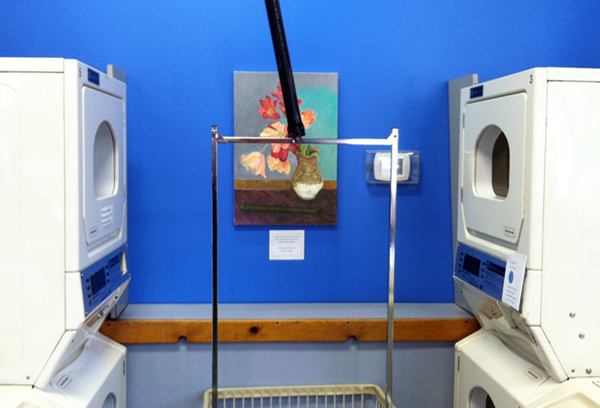
Whatever it says about the man or his work, Offenbacher’s paintings look awesome here. They pop against Lather Daddy’s loud, cobalt blue walls. They're at home among the monotonous drone of churning fabric, the half-full candy dispensers and wearily blinking arcade lights.
According to a sheet of paper sheethed in a plastic sleave, the paintings are “proudly transitional and regressive.” At Lather Daddy, they’re intended as a “palliative for waiting, boredom and everyday work.”
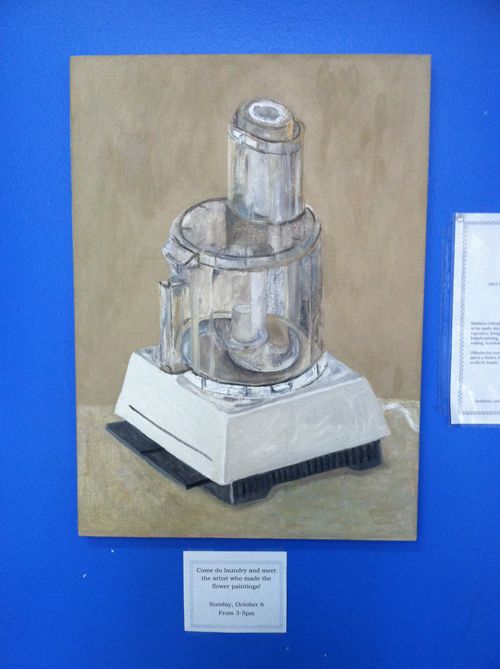
One of said palliatives is a painting of an empty food processor at rest against an enervating, taupe background. Another: a loose bundle of peach and vermillion tulips drooping listlessly over a flute. Sandwiched between two washers, a black cat framed by muddy, mauve wallpaper peers menacingly across at the neighboring painting of a bouquet on an ochre tabletop.
Everything is laughably dull, decorative and pretty. The paintings defy you to like them. There’s one that simply glows, however. It’s a bundle of bluebells stuck in a vase with a bunch of drooping, white bellflowers. Everything is an ecstatic storm of brushstrokes. The palette is as color-promiscuous as a box of smashed Fruit Loops. It hangs just above an ATM and to the left of a Terminator 3 pinball machine.
Instead of placards with titles, notes are taped beneath all the works: Come do laundry and meet the artist who made the flower paintings. Sunday, October 6 from 3-5pm.
If you have dirty laundry this weekend, this is where to bring it.

June 5, 2013
2013 VISUAL ART GENUIS AWARD FINALISTS
by Jen Graves
[...]
In recent years, disillusioned by any number of utopias gone wrong and various hypocrisies exposed, some very interesting artists have created work that upends the sentimental notion that art is a moral good—and that has been fun. Matthew Offenbacher is not one of them. He is an unstylishly gentle soul who somehow, in any given room, also manages to get across the one thing that really needs to be said. He’s a painter, a reader, a writer, and an editor, and he’s the closest thing contemporary art in Seattle has to a non-sceney, grassroots community organizer. He publishes La Norda Specialo, the artist’s zine, where in 2009 he wrote the essay “Green Gothic,” the most influential essay to hit Seattle art in an age (and the subject of a recent exhibition at Seattle University), drawing together the handsome and remedial decay of Gas Works Park with streaky, rain-on-windshield sketchings of Kurt Cobain YouTube stills (by Gretchen Bennett) and the forest-embedded monsters of Twilight. It was a dazzling synthesis, both ambitious and completely down-to-earth, capturing what one writer, Seattle musician Emily Pothast, called a defining characteristic of his paintings, too: They are “freakishly egoless.”
Consider that even the most stripped-back art is almost always inherently showy and egotistical—it just goes with the territory of artmaking—and you begin to see why Offenbacher’s creations can be so surprising and layered. They are often bright, often of cheerful subjects, and often painted on stain-resistant fabrics that fight being painted on, creating a balding, otherworldly texture (not to mention a productive and literal tension between the image and the surface). His visions are not unlike folk art, and they don’t exactly fly off the walls into fancy collections. One recent exhibition was designed, only halfway-jokingly, to be installed inside a spaceship in order to improve the lives of astronauts. You find yourself not so much distantly admiring as leaning into and sympathizing with Offenbacher’s works; they’re vulnerable, funny, and holding out a hand. They carry an ethos that’s essentially queer, one level of which is simply Straight boys don’t make paintings of flowers in 2013. But Offenbacher’s unfenced flowers somehow refresh a worn-out innocence about, say, the fact that flowers are a really great thing to make a painting of. His art reminds you about believing in things.

August 7, 2012
I LOVE WHAT YOU'VE DONE WITH YOUR SPACESHIP!
Matthew Offenbacher Improves the Lives of Astronauts (and Others) at SOIL
by Jen Graves
It is hard to tell time when you’re in a spaceship. Biorhythms are lost in the absence of an earthly day and night, just like during a 24-hour sunlit day in the arctic, or a sensory deprivation chamber, or a place where you just can’t move around that much, like a nursing home. Matthew Offenbacher’s newest show, Decor for Interstellar Flight at SOIL Gallery, is a proposal for how painting might solve the problem of having your natural self interrupted.
It’s both funny and sincere. In several shows over the last few years, the Seattle artist has experimented with making art powerfully transformative while also helpful or healing instead of domineering or egotistical. His aesthetic is political: Feminism and queerness are central to what he makes, and how do you make a queer painting? The answers he puts forward are itchy and witty and unexpected.
What you see at SOIL is a patchwork of painted panels, like a solid quilt covering two walls and the corner joining them. A gap in the upper-right corner of the quilt is a blank where another panel could go; leaning against a wall nearby is the missing panel, suggesting the quilt is unfinished and unfixed. Offenbacher has made many paintings on stain-resistant fabric that look like the paint is hovering over the stubborn surface. But those, on wood stretchers, would be entirely too heavy for space travel. So the Decor for Interstellar Flight paintings are instead paper collaged onto Styrofoam panels (so light! So practical!). The patterns—wavy lines, hand prints, fields of color, vines on a trellis—still have a strange look, not sitting firmly on the surface. The effect this time is because the artist applied clear acrylic medium on the paper to glue it down, then poured and smudged powder pigments.
Many of the surfaces have raised portions, because in his research, the artist discovered that texture helps renaturalize the body. These panels are prototypes for a whole system of lightweight two-sided pieces that astronauts can switch out every day, providing a choreography of humanizing scenery inside the ship. On the floor is a pile of oranges in an oversize, pearly papier-mâché seashell, completing the set piece. (These oranges taste like they’re from outer space, and they may as well be; they arrived at a local grocery store from New Zealand, the artist notes.)
Offenbacher is also a writer; he publishes the artist zine La Norda Specialo and at SOIL created a takeaway newsletter on cheap gray paper in typewriter font. The text—you’ll love it, don’t miss getting a copy—is a collage of writings from spaceship interior design researchers, Greek mythology historians, tales aboard a long ship voyage, and a calendar of birthdays in August from members or relations of SOIL Gallery (the closed community at hand), all peppered with erotica. "Compared to ‘normal’ life on Earth, the relevance of social interactions increases considerably when individuals live under extreme conditions in a harsh environment," researchers write. But what defines a normal life on Earth? It’s a question worth contemplating among New Zealand oranges and white-cube rooms.
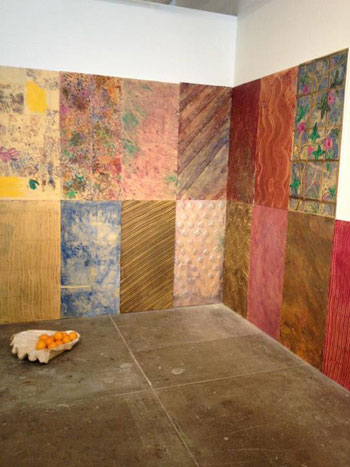
Matthew Offenbacher’s Decor for Interstellar Flight at Soil. Photo by Jen Graves for The Stranger.

September 6, 2011
JOY AND ELUSIVENESS
The First Show at Prole Drift Is Post-1970s and Straight Out of the 19th Century
by Jen Graves
Prole Drift is a new gallery in the International District. Let’s not concern ourselves too much with it yet because, whatever its big ideas, its future is still in front of it and we will see it then. Right now, what’s to be seen at Prole Drift is An Empty Vase, a show that takes the form of a gallery-within-a-gallery. It’s an airy box built by the artists in the white cube of the architecture, and there’s a miniature version of this gallery-within-a-gallery on display within that.
Much of what’s seen here is made of paper, or some sympathetic material or treatment—things you could imagine being thrown away, things that have been folded, paintings made by pressing 3-D flowers made of dried acrylic paint between the pages of books and then attaching those pressings to a canvas as if they’d been painted there all along. The artists involved are some of the most clever and wonderful Seattle has, led by Matthew Offenbacher and Jenny Heishman, who envisioned the structure and frame for the show—the title An Empty Vase is taken from a writing by Heidegger in which he admires a vase for its ability to be grounded at its base but open at its top.
Each work in this show is mounted on this cube of hinged Styrofoam walls. The hinges mean that the walls can shift the way view windows do, and the artists manually change the tilt of the walls every few hours, meaning the show changes, the way the pieces intersect and reflect each other changes—but always, as the visitor, you find yourself both looking at the walls and looking beyond them, through this cube with an empty center, to the other visitors across it. You see them seeing. You also see tangles of metal that look like mounted abstract sculptures on the Styrofoam, but they are not sculptures or works of art at all, they are the ties of metal holding the piece of art on the wall on the other side. Balance is a central theme of the show; when you see one thing (connected ground), look for a corollary (open sky). A drawing that says, “You suck” by Gretchen Bennett has another drawing on the other side of the wall from it, so they balance each other perfectly, no tangles of metal needed. On that other side, it says, “No I don’t.”
Heishman, Offenbacher, and Bennett work alongside one another in studios off Dearborn, in Sodo, and have shown collaboratively before (Light Show for UNESCO in 2008, Second Peoples in 2009; note: Showing collaboratively means more than just showing together). And they’ve managed here, again, not to simply make things privately that will then be shown according to given public conventions, but to seep their creative process into the gallery space, almost like a writer saying just what she means, and being understood, without using any recognizable words.
This mise-en-scène is a base for joy, love, obsession—qualities not typically associated with the white cube, but harking back to 19th-century cabinets of curiosities. This show was inspired by Sir John Soane’s Museum in London—hence Bennett’s sticks found in the shapes of letters spelling out the word “Soane” near the entrance. The intention of these artists is not confrontational; their attitude is less direct than the 1970s institutional critique artists who’ve influenced them. But their intention is no less radical: elusiveness. Heishman’s sculptures are already mysterious, and here she shows only printed-out images of them. Look what paper can do to the meaning and appearance of a real thing! When you go to this gallery, I have no idea in which direction its walls will be folded.

July 1, 2010
ART OF CONVERSATION
by Suzanne Beal
With La Norda Specialo, visual artist Matthew Offenbacher is turning visual artists into better writers, with the goal of making them better artists.
Artists’ statements are used for everything from grant applications to museum and gallery wall texts. They’re designed to illuminate an artist’s intentions, but many artists dread writing them – “If I wanted to write,” they often point out, “I would have been a writer.” Enter Matthew Offenbacher, painter, curator, and creator and editor of the free, independently published zine La Norda Specialo, aka La Especial Norte. Offenbacher has made it his business to convince artists that they can and should write, and that the results can benefit them all.
Although the zine is available to non-artists at about a dozen bars and galleries in the Northwest, including the Hideout, Greg Kucera, James Harris, Lawrimore Project, the Henry Art Gallery and the Cooley Gallery at Reed College, it was primarily created to motivate artists to read about visual arts being produced locally. The ultimate goal? “To make us all better,” replies Offenbacher, smiling. “The higher the quality of the conversation, the higher the quality of the work.” He doesn’t intend for the zine to continue indefinitely. “That’s what makes it an art project and not a new magazine in town,” he explains.
Upon arriving in Seattle four years ago, Offenbacher became acquainted with artist Jenny Heishman. Together they began organizing artists’ visits to studios around town, and found inspiration for the zine in the resulting dialogues. “Collectively we felt like there weren’t enough writers proportional to the work being produced. Artists often complain about the lack of writing about visual art – but if anyone is going to do something about it, it should be us.”
Offenbacher is no stranger to collaboration. As the force behind the Gift Shop Project at the Henry Art Gallery, an almost eight-month-long project involving six collaborative installations and performances, Offenbacher connected more than seventy Seattle artists, whose collective talents transformed the museum’s abandoned gift shop into an alternative exhibition space.
Likewise, La Norda Specialo was conceived as a means of putting artists behind the wheel. The first issue appeared in April 2008. Since then, Offenbacher has produced six issues out of his home and his studio. Published contributions have appeared as poetry, art criticism, interviews and short stories. A special issue edited by visual artist Margot Quan Knight (a recent Art Walk Awards winner) included Victoria Haven’s mock e-mail advertising an artist residency program destined for space that required a nonrefundable processing fee of ten thousand dollars – unless, that is, “the artist can provide documentation of rejection letters outweighing acceptance letters by a ratio of thirty-seven to one for previous art-related applications.”
La Norda Specialo also publishes illustrations – the type of drawing you might see while peering over an artist’s shoulder and into his or her sketchbook. In issue number five, Jenny Heishman suplemented her commentary on Seattle artist Robert Yoder’s August 2009 show, Send Me an Angel, with a loosely drawn sketch of a horse and its big-haired rider inspired by a 1983 video by pop band Real Life. “You learn a lot about something by looking and drawing,” says Offenbacher.
A 4Culture grant allows Offenbacher to pay a small honorarium to contributors. “Artists are often asked to labor for free, so I want people to calibrate their efforts to the work.”
Until recently, Offenbacher would assemble La Norda Specialo at either his home or his studio, then pay to have it photocopied in the University District. In an effort to find a locally owned digital duplicator that he could use to print his zine, Offenbacher called Witt Company, whose management offered to give him a machine earmarked for the scrap yard. It now occupies a corner in Offenbacher’s South End studio. The new acquisition creates a stencil that wraps around the cylinder, much like a mimeograph. “It’s cheaper to run than a photocopier and way faster. It’s more like a printing press than a photocopier.”
Offenbacher conceived of his zine as a print publication rather than a blog because he wanted to incite people to visit galleries and museums to pick up a copy. “In the arts community, the exchange of ideas can be too frictionless and anonymous.
“Society tells artists that what they do is only marginally important, and because of that visual artists often feel very disempowered. But the words surrounding the production of art are extremely important. If artists don’t take ownership, someone else will.”

Photographs by André Mora for City Arts.

It may look like a laser printer, but a Risograph machine, shown here at Offenbacher’s studio, uses real ink like an offset printer, prints faster, and is less expensive per page.

October 27, 2009
ART IS EMBARRASSING
A Tribute to Matthew Offenbacher’s Tribute to His Cat
by Jen Graves
Matthew Offenbacher’s third solo show at Howard House is called C.A.T., after a series of 1917 drawings dubbed “Conventions for Abstract Thoughts” by the artist Charles Burchfield. This show consists entirely of paintings of and about Offenbacher’s cat.
It may sound funny, but it’s not a joke. At a recent talk Offenbacher gave, someone asked him whether he’d ever dreamed of being a standup comedian, and while Offenbacher in person is not at all jokey, the question made a certain amount of sense. The connection is embarrassment.
The new paintings are made on a thin Stainguard fabric that resists the paint, meaning that the paint literally sits uneasily on its surface. This happens on a stylistic level, too. Certain passages resemble the crayon-resist paintings made by grade-school children, while others look like high modernist abstraction (Orphism in particular, which was like cubism plus color and cosmic longing). In the past, Offenbacher has made geometric abstractions that ask you to imagine they were made by beavers, or self-described “repulsive color combinations,” or depictions of owls and wolves patterned after macramé and yarn art. In a 2007 review, I described his work as flirting with the tradition of bad painting, but that’s not quite it: It’s embarrassing painting. There is something deeply embarrassing about Offenbacher’s paintings. They are embarrassed to be paintings–as if it were just an embarrassing thing to be a painting, so fancy and loaded and ambitious–and you are embarrassed to be looking at them, and in this way a connection is made. A house cat may have no shame, but that’s the luxury of the subject of an artwork. The viewer and the artist have no such luxury. We have to wonder what this thing art is, and we have to justify our belief in it. And doing that–explaining a faith in something as insecure as art–is really hard and definitely embarrassing. This is where half-truths, clichés (creative types are just so weird!), and egos come in.
Offenbacher pushes his paintings beyond all this into a sort of awkward, liberating confidence. To proudly present a large painting of your cat’s face upside down on fabric that rejects the paint itself–it is an act of freedom, of perverse strength.
Offenbacher’s art-making is centered on painting but not limited to it–his paintings take up just a corner in the salon he’s invisibly organizing. No other Seattle artist is so unassuming and yet such a power source. He’s not charismatic in any traditional sense–he has floppy, curly hair; boyishly large eyes; and a feminine way about him (he’s straight), like one of those delicate figures hanging out improbably in the corner of a history painting, away from the action–yet he is Seattle art’s community organizer.
Since moving here in 2006 from San Diego, Offenbacher has not only had three solo shows but also organized two substantial group shows with Seattle artists (at Helm Gallery in Tacoma and the back room at Howard House). He has founded, edited, and published five editions of La Especial Norte, a broadsheet zine with essays, porn, and stories by artists living and dead. He has written two terrific long-form essays for La Especial Norte (on “green” gothic and on shit in Northwest art). He recently won Seattle Art Museum’s 2009 Kayla Skinner Special Recognition Award. And now, he is running the defunct gift shop at the Henry Art Gallery as The Gift Shop, an ongoing installation with changing displays that will raise subtle questions about how a place run by artists inside a museum might be different from the rest of the museum.
Offenbacher’s vision for art is one without cults or cliques, but not without dreams. In a letter he wrote in 2005, he described his nostalgia for 1960s ideas about communal living that he remembers from a book of photographs he found at his grandparents’ cottage in Vermont when he was young. “I wanted [my paintings] to show more the possibility for construction, connection, communication, for hope and belief in painting’s transcendent endowments.” In the same letter, he acknowledged, “I mostly wanted these to look sort of familiar, but also strange, alien, off.”
That “off” quality is the essential ingredient in Offenbacher’s work. His curled-up cat painted in a riot of swirling colors exudes eyes-closed bliss and belonging–but the painting is also “strange, alien, off”, streaky, and tentative in places, the cat’s back elongated in an unsightly way. In another painting of the cat sitting upright, its paw is stretched into an oversize, monstrously webby foot. Its eyes, again, are closed. We are made forcibly aware of this alien quality, even though the cat is oblivious. Painting is a state of mind suspended between doubt and belief. It’s private but public. Bringing private and public together, wanting to believe, always means being embarrassed. But what’s the alternative?
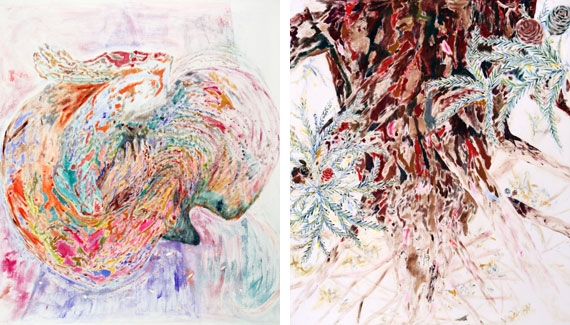
NONABSTRACT THOUGHTS: The cat’s name is Turtle. He once got stuck in a tree.

October 28, 2009
Cat: A Tonic. (Or, the Disarming Sincerity of Matthew Offenbacher)
This week in The Stranger, Jen Graves reviewed Matthew Offenbacher’s C.A.T., installed at Howard House through October 31. Like most reviewers of Offenbacher’s work, Graves makes generous mention of his numerous outside projects that make him one of the Seattle art community’s most ambitious organizers. But when it comes to his work, her verdict is slightly less charitable, at least on the surface:
There is something deeply embarrassing about Offenbacher’s paintings. They are embarrassed to be paintings—as if it were just an embarrassing thing to be a painting, so fancy and loaded and ambitious—and you are embarrassed to be looking at them, and in this way a connection is made.
To be sure, Graves admits to being won over, if not by the peculiar charm of the paintings themselves, at least by their eccentric heroism:
Offenbacher pushes his paintings beyond all this into a sort of awkward, liberating confidence. To proudly present a large painting of your cat’s face upside down on fabric that rejects the paint itself—it is an act of freedom, of perverse strength.
I commented on her post that Matthew Offenbacher is probably my favorite painter in Seattle right now, for reasons I had not yet attempted to put into words. But I am inspired to do so now in response to the charge of “embarrassing.”
I’m fairly sure I see the qualities Jen Graves reads as embarrassing. Offenbacher’s canvases are awash with garish color combinations, rendered with an anachronistic expressiveness and a disarming sincerity, and garnished with a calculated whiff of naïveté. But I wouldn’t say I’m embarrassed by them. On the contrary: I think I’m more likely to find myself “embarrassed” by artwork which lacks these qualities altogether. (Like art that desperately wants to convince us of its “smartness” or “hipness,” for instance.)
Offenbacher’s work is refreshingly free from all traces of pretense. He has a cat that he likes, so he paints the cat. He paints other things too. These things are important, but not nearly as important as the voluminous, interpenetrating Space Between Things that gets rendered with all the exuberant, idiosyncratic delight of a psychologically tetched outsider.
The resulting images are resoundingly charismatic; so confident in their freakishly egoless self-ness that they make us keenly aware of our own pretenses. If Offenbacher’s paintings cause us any existential discomfort, perhaps it is because we know that we are nowhere near as much ourselves as they are.
Matthew Offenbacher’s C.A.T. is up through the end of the week at Howard House. Thanks to Jen Graves for the inspiring food for thought, as always.
—Emily Pothast

April 21, 2009
INDIAN GIFTS
By Jen Graves
[...]
At the Helm Gallery in Tacoma, another show of a group of artists—Gretchen Bennett, Jenny Heishman, Heide Hinrichs, and Matthew Offenbacher, working so closely together, even sharing materials, that they are loath to call theirs a group show—leans on ancient bedrock. This time, though, ideas of nativeness are called upon in the generational sense, to represent every past from which the artists are alienated and with which they long to reunite in order to move forward into a new (possibly impossible) independence. “We are the second peoples. We inhabit a landscape of iteration, reverb, elision, and generational noise,” their statement reads. Second Peoples, the title of the show, refers to the universal dilemma of “being born into a world that already exists,” as artist Corin Hewitt put it to me recently. (Hewitt has an exquisitely tender show of photographs at Seattle Art Museum now.)
Blowing past referentiality into a new future integrated with the past—this is what David Foster Wallace meant when he urged his generation to drive beyond ultimately despair-inducing irony. The idea is to do more than appropriate, to use but not use up, to keep the gift moving. Offenbacher plays a piece of carpet padding against an abstract painting. The padding hangs on the wall, like a piece of art; the painting sits on the floor, like a scrap of something. They share the same color scheme and mosaic appearance, which pleasantly undermines them both. While the abstract painting comes down to earth, the mass-produced padding seems to achieve the spiritual: They laugh at (and with) each other. (Bonus: The colors in the painting seem to hover on the surface because Offenbacher's canvas is not canvas but fabric treated with Stainguard—i.e., the painting treats its own paint like a stain it doesn’t want.) Across the room, Heishman sets a piece of tinfoil on fire by decorating it with mirrored stickers and hanging it perpendicular to a piece of fabric the blazing colors of a sunset. Maybe the best evidence of an updated sublime is the undying desire for it. At the very least, artists are banding together to work on this knot of riddles for you.

December 2, 2008
THE BACK ROOM
Past the nice big galleries with high ceilings at Howard House is a crowded area with rows of plastic-wrapped paintings leaning on each other and a few unwrapped artworks sitting or hanging, attempting to exhibit themselves despite their surroundings.
Leading away from that area is a low tunnel-like corridor and a doorway to the back room, where past visitors have stumbled upon and squeezed around a lawn chair held aloft by balloons, and videos of real chained-up motorcycles going crazy trying to escape, and paper sculptures of birds in snow. This room is ugly, claustrophobic, and has a bumpy floor. But art people are in the business of transubstantiation. So this ugly, claustrophobic, bumpy room is called Project Space, which makes it sound like it could one day become a very important place.
Today is actually sort of that day. Seattle artist Matthew Offenbacher has transformed the back room into Light Show for UNESCO.
The light show is on the walls, where the whiteness is deeply dyed by a ceiling track of lights in the colors of a tropical sunset. The walls look so good, so soft and concentrated and glowing, that hanging anything on them would be wrong. The gallery director compared the project to the transformation of a regular old place (unlit) into a UNESCO World Heritage Site (rapturously well-lit!).
In the middle of the room, with a single neutral light falling on it, is a hollow plywood box. The box’s top surface is a platform for a miniature art show of miniature artworks, each one strange and lovable and slightly unsightly in its own way, presented like a collection of trophies and plaques for the misunderstood.
The objects include a painted ceramic elephant and circus ringmaster the size of salt and pepper shakers (by Jeffry Mitchell); a thin white thread with three pearl balls on it (Heide Hinrichs); a dried dahlia and books on various subjects (Egyptian wall paintings, rocks and minerals); a lumpy clay ashtray that appears to depict coitus but does not (Offenbacher; it’s Narcissus and his reflection); a foamy spray-Styrofoam lion (Jenny Heishman); a totemic figure wearing a staircase dress (Claudia Fitch); two flat, screaming, eyeless faces (Gretchen Bennett, adapting designs from stickers).
On the back of the box, hung low, Bennett has glued a bad print of a blurry drawing she made of a disco ball. The difference between the degraded print and a real, glinting ball aches. The whole room aches. A handout says that Offenbacher used the three-part UNESCO mandate to create the show: “1. to promote diversity, 2. to mobilise active forces, and 3. to fertilise.”
—Jen Graves
The Stranger Suggests for Tuesday, December 9
LIGHT SHOW FOR UNESCO
Never has so much looked so good in such a tiny, ugly room. This is a group show of some of Seattle’s greats (Gretchen Bennett, Jeffry Mitchell) in modest miniature, organized by artist Matthew Offenbacher, who basically turned the back room at Howard House into a rapturously lit UNESCO World Heritage Site. The bits are like fragements from a lost civilization: Jenny Heishman’s foamy lion, Offenbacher’s coituslike Narcissus ashtray, Bennett’s achingly degraded drawing of a disco ball. (Howard House, 604 Second Ave, 256-6399. 10:30am-5pm, free.) JEN GRAVES

April 22, 2008
LA ESPECIAL NORTE, #1
This morning the painter Matthew Offenbacher handed out two folded 8 1/2 by 14 sheets of brownish paper printed on both sides and with the title “LA ESPECIAL NORTE 1” across the top.
And that marked the arrival of a brand new Seattle artist “newsletter”—a thing like a zine, but not the kind put out by snotty teenagers. This is a publication made by artists. Career artists. Artists like Joe Park, Gretchen Bennett, Eli Hansen, and Offenbacher himself. And still, I worried it would be tragic.
The thing is great.
There’s an essay about shit in Seattle art (hence the brownish paper color?) by Offenbacher, and it’s better than most of what passes for essay writing in art magazines, drawing together works from Eric Elliott’s paintings to Susan Robb’s transformation of her dealer’s shit into art in a show opening this Thursday. (Offenbacher declares Stranger Genius winner Alex Schweder “our old master of [the] genre.”) What else? Porn by Hansen, Bennett’s personal, narrative “philosophy of street art,” Park’s interview with old-time Seattle curator Chris Bruce, and a reprint of Robert Smithson’s 1972 essay “Cultural Confinement,” which seems to suggest that Seattle artists are bristling below their polite surfaces.
As for images, there aren’t pictures of art in La Especial Norte, there are drawings of art. Which is better. (There’s a detailed scribble of Jenny Heishman’s Mud Thing, for instance—seen for real here—and a sketch of a 2005 staged wedding between artist Steven Miller and a pile of dirt. Bonus: I had no idea Steven Miller “married” a pile of dirt!)
I have no idea where you can get a copy. But the masthead-like thing on the back page says to contact northern.special@gmail.com for more information. It also says La Especial Northern will come out two or three times a year. I’m ready for the next one now.
—Jen Graves

October 10, 2007
Matthew Offenbacher is involved in a practice that still is
startlingly dangerous, although it is not new. “Bad painting” began in
the 1980s. Offenbacher’s update on the genre continues its flaunting of
conventions of taste (though with all the ironic reversals, it's hard
to remember whether
tie-dye and mosaic are out or in at the
moment), but deletes the attending sneer. His folksy ‘70s scenes
populated with animals—beavers, otters, horses, weasels,
owls—channel historical modes of “transcendental” painting
(Kandinsky, Robert Delaunay, Malevich, Rothko) as well as the
spiritualist crap sold at, say, Pike Place Market. They draw together
those old poles of avant-garde and kitsch under an umbrella of
tenderness. Which is weird. And risky.
He doesn’t always pull it off. An Alfredo Arreguin—style
painting of a coyote on a hippie-dippie pointillisty ground is just a
bad painting, not a good-bad painting. Paradoxically, it suffers not
only from simplistic derivativeness but also a failure of skill. The
coyote is inert, the background muddy instead of sparkly.
But when he does pull it off, the paintings have good hearts and a
lot on their minds. They’re trying to figure out, like so many
post-abstraction post-figurations, how to square the voyeuristic,
religious sublimity invested in wilderness (and painting) with the
total skepticism of modern life and art. Where many artists draw out
the doubt of the viewer in order to toy with it, Offenbacher wants to
draw out faith as an equally fecund proposition. It's timely,
considering the coinciding popular terror of both religious fanaticism
and natural disaster.
His show’s title, Captain of a Huckleberry Party, invokes
American transcendentalism by referencing a criticism of Thoreau by
Emerson. Thoreau could have been somebody, captain of the world, but he
just hung out in the woods, captain of his own little huckleberry
party, Emerson charged (in a speech at Thoreau's funeral, no less). The
notion of private pleasure versus public action has echoes in historic
constructions of femininity and masculinity as well as in historic
theories of painting (the picturesque and the sublime, swishy pop and
tough-guy abstract expressionism).
Burlap covering the white gallery walls and a cheesy dark-wood
molding form the ideal innocent yet lightly knowing backdrop for a
painting of two cavorting otters (even formed loosely into the dreaded
yin-yang pose!) seen from underwater, the aqua-stained canvas bleached
to depict the light of the sun above the water's surface. In another
painting, Some Rothko Problems, three adorable white weasels
feast on the psychedelic, floating carcass of a horse. They’re
almost paintings that a New Ageist might hang in the den, but
better. Or worse?
—Jen Graves

October 18, 2007
Matthew Offenbacher paints as if he’s weaving, which gives his work a folk art quality. He also paints in pure streams, simulating the abstractions of early 20th-century innovators such as Sonia Delaunay. His paintings are about painting, and each is a dive into history's pool.
“Exhibition” is a response to Whistler's “Peacock Room.” Instead of peacocks, Offenbacher offers turkeys with paint gems at their feet, signifying the conflicts of the original commission.
What is painting for? It can celebrate the process of a brown burrowing mole, as in a painting whose title begins, “Recognizing the diligence with which death approaches.” It can fill the night air with intimate consequence, as in, “Some Rothko Problems,” and it can color the moon as Thoreau saw it from Walden Pond, after Emerson said he was wasting his life.
One thing is certain: Offenbacher is not wasting his.
— Regina Hackett

June 9, 2005
Do beavers do architecture? Sculpture? Matthew Offenbacher’s art makes you think about such questions, which are fun to ponder and a touch provocative in their implications.
After all, we tend to think of culture as something separate from nature. And while beavers aren’t about to make objects from marble or galvanized steel, might their impulse to build go beyond the merely functional?
Offenbacher, who lives and works in San Diego, clearly enjoys parallels between nature and human culture, which is one reason why he's chosen to paint beavers. Then, asking you to suspend disbelief, he makes paintings as he imagines beavers might—if they had the wherewithal to paint. Thus, the two meanings of his exhibition title—“Beaver Painting.”
This show, Offenbacher’s second at Quint Contemporary Art in La Jolla, picks up where his 2004 exhibition left off. Then, he was looking at the gray area between nature and culture from a different vantage point. The paintings exploited the similarity between animal hides—deer, otter, skunk and squirrel—and the sort of color field paintings of the 1960s that emphasized flatness and pattern. Sequoia resembled a slice of giant tree trunk that led you to the same sources in recent art history.
They were conceptual art with an Americana bent. They were also trompe l’oeil paintings—though their illusionistic effects weren't as proficient as they should’ve been.
Now, with the beaver pictures, he’s rendering landscapes of a sort. Painting With Picture of Its Own Construction is thick with line created by branches and twigs—its structure derived from the sort of building that a beaver might do. And right in the middle of the scene, hovering on a branch and casting an eye the viewer's way, is a rather charming looking example of the species.
There are two beavers in Painting Thinking More or Less, one on a beaver-built structure and the other in the water. Of course, the artist is thinking about painting in the making of this canvas and this show. But the implication is that we are to consider about how much a beaver thinks about what he constructs.
Once we start looking at the wood configurations within the paintings, other parallels appear. The beaver edifices have “God's Eyes” macrame patterns within and prismatic colors, as if there were something retro about musing on nature at all. And there is a nostalgic aspect to communing with nature, of course, which Offenbacher is planting into the mix with his allusions to a 1960s craft craze; it was a back-to-the-land era.
His different concerns don’t quite cohere. There is a stream-of-association quality to these paintings, in which he's thinking about the intersections of human and animal creativity at one moment and the relationship between nature and the 1960s in the next. All quite interesting, but the thematic road map to these works takes you in too many directions at once.
Then there are the paintings that beavers would have made, if they were in a modernist frame of mind. Geometry dominates: the little canvases mingle flourishes from cubism and one of its American offshoots, synchronism. One wonders how these beavers learned their art history—or maybe they just don't know they’re repeating it. At any rate, their abstractions need some work.
Offenbacher has surely anticipated the fun a viewer can have, spinning scenarios about the paintings “made” by beavers. But his images of beavers turn out to be a lot more engaging.
— Robert L. Pincus

April 2004
The straightforward imagery of American wilderness in Matthew Offenbacher’s
intriguing paintings arouses curiosity which he sustains with his
skillful techniques and intellectual ideas. His recent work resembles
cross sections of sequoia tree rings, animal hides and large-scale
pages of pressed wildflowers that, in their simplicity, evoke childhood
memories of tales about Daniel Boone and the stories of prairie life by
Laura Ingalls Wilder. But Offenbacher’s subject matter is not so much a
commentary on romantic American idealism as it is a complex riddle that
ties the American frontier with American modern painting, painting in
general and the myths and nuances that surround these various
concepts.
Painting, or rather traditional realistic European
painting, was challenged by artists throughout the twentith century,
especially by American abstract painters who wanted the flat plane of
the canvas to be recognized, and Offenbacher is having fun oscillating
between the desire of the artist to vivdly recreate the real while
simultaneously commenting on the nature of this act.
Nowhere is this more obvious than in four works that resemble their titles.
Deer Pelt, Otter Pelt, Skunk Pelt and Squirrel Pelt, by
way of canvas shape, paint color and technique, appear to be the real
things. Such thorough mimicry precludes comparison to seventeenth-century Dutch painting because they kept their subject matter within
the confines of a rectagular canvas that never igonored perspective
whereas Offenbacher tricks us into thinking these are actual animal
skins.
Offenbacher’s wildflower paintings also tweak our
perceptions of reality in that the paper fiber on canvas looks like
actual pressed flowers. Pansies, a small oval-shaped canvas that
could easily be found hanging in a nineteenth-century American home, is
especially remarkable for its authenticity, as is Fern and
Dandelion. It is only in a work such as Morning Glory,
which is modern in the large size of the canvas and the fact that the
flowers fall off the canvas, that Offenbacher’s cunning playfulness
becomes apparent. The realism of this work begins to resemble
abstraction. What, we begin to ask ourselves, is the artist really
depicting?
This question becomes particularly important in the
six Sequoia paintings: what appears to be cross sections of
unique tree trunks, are also clever allusions to the minimalist pattern
paintings of the 1960s. The artist’s toying strategy of placing two
opposing American ideals within the same context is most obvious in a
number of works that depict illustrated animals but which, in their
titles, refer to recognized works by famous American abstract artists.
Looking at Big Red by Sam Francis, a small, simple straight-
forward drawing of a polar bear in tones of gray, white and black,
contradicts Sam Francis’s painting at the Museum of Modern Art, New
York, which is lush in its field of rich shimmering reds and receding
grays. Similarly, Looking at One (Number 31, 1950) by Jackson
Pollock (also at MoMA), a small rendition of a bat, in no way
comments on Pollock’s drip masterpiece full of dramatic gestures and
lyrical movements. Which takes precedence, the image or the title?
In many ways this exhibition is about myths but it is also about
idealism, ideology and the purely conceptual. Offenbacher, by way of
his subject matter and painting style, cunningly makes us think about
American values, American traditions, American folklore and the very
different aspects of American Art.
—Victoria Reed































